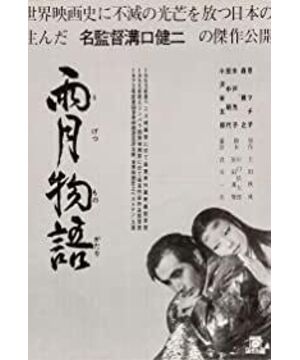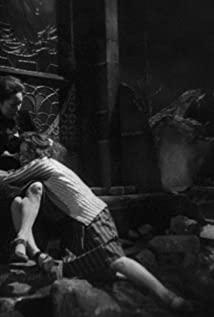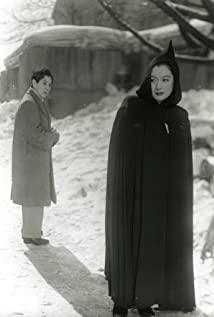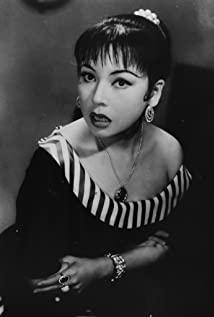(1) The Fable of the Oriental Image
of the Shredded Cocoon This film is adapted from the novel of the same name by Ueda Akicheng, and this novel by Ueda Akicheng is influenced by China's "Cut the Lantern News" and "Three Words and Two Pai". Therefore, it is not difficult to understand that when we saw Genjuro meet the beautiful rich lady Wakasa in the film, and he was in a state of indifference and intoxicated, and later discovered that Wakasa turned out to be the incarnation of a female ghost, and woke up in the residence of himself and Wakasa. In fact, when there are ruins, we can't help but think of the scene where Bai Niangzi and Xu Xian met for the first time. There may be many viewers here who think that this very simple fragmentary reference is far less exciting than Chinese ghost novels, and the problem is that most of China's ghost novels are presented in the form of TV series, when they are put on the big screen. Acts are often lackluster, and the reason is that most of China's current film and television adaptations of strange novels pay too much attention to dramatic plots, the creation of complex visual spectacles, and the sense of curiosity. ” and other films, very few strange novels fully pay attention to the exploration of “divine nature”, “magic nature” and “human nature” in the original work when adapting the film, and they do not focus on the allegory of human nature and society behind the bizarre plots. full discussion.
And Mizoguchi Kenji's preciousness lies in this. The film is adapted from the two novels of the same name, "Asakusa Su" and "Snake Sexual Prostitution", which are adapted from "Ai Qing Biography" and "Jing Shi Tong Yan" in China's "Jian Deng News". "The White Lady Yongzhen Leifeng Pagoda". It seems that Kenji Mizoguchi has only retained a small part of the original work, but in fact it is the retention of this small part that plays a crucial role in the discussion of human nature and the sublimation and hinting of meaning in the entire film. The film is divided into two main lines, one is Genjuro and his wife Miyagi who are full of wealth, and the other is Fuji guard and his wife Abin who dream of becoming a samurai. There is a depth of field shot at the beginning of the film, the foreground is Genjuro and his wife working together lovingly, and the background is the Fuji guard who is arguing with his wife because he wants to become a samurai. From this shot, it can be implied that Genjuro actually loves his wife deeply, and Fuji guard is dazzled by the glory of the samurai. After a long time, Fuji Guard finally became a samurai by accident, but when he was looking for fun, he saw his wife, who had become a prostitute because of her neglect; In the village, he finally found out that Wakasa was just a lone soul. The drunken wine pond and meat forest had already turned into a fireworks bubble when he woke up. When he woke up and went to look for his wife, his wife was killed due to the war, and he was separated from him forever. . At the end of the story, the two brothers have returned to the original point, but everything has long been unable to return to the past. The setting of the character of Wakasa, the fall of Abin, and the passing of his wife Miyagi are all to echo the theme, or to reflect the two men and their inner desires and selfishness.
Through such a seemingly bizarre and bizarre style story, the whole film explores the desires in people's hearts to us. Everyone has desires, and when he exceeds the limit he should be, he is terrifying, and he will grow uncontrollably. In the movie, two men are the subjects of desire, one for wealth and the other for the glory and dignity of the samurai. They are fearless and can go to the cave to check whether the porcelain is well-fired at the risk of war, and can be admired samurai. Leave the wife alone. They seem to have been firmly driven by desire, as if they are on a road with no turning back, desperately driving themselves forward, abandoning everything and desperate. The setting of the female ghost Wakasa is the object of Genjurou's desire. Once Genjurou had a conversation with his wife, the wife said that he felt very satisfied, but Genjurou felt that he wanted to have supreme wealth and to get rid of the daily labor. . Wakasa appeared after Genjuro made a fortune by buying porcelain. He was very proud of his wealth, and he met a beautiful woman, so he naturally indulged in it and forgot his wife. Finally, when he realized that yesterday's goodness was nothing but a dream, His wife has left him. As for his younger brother, Teng Weibing, after he became famous, he saw his wife Abin was ravaged in every way because of him, and finally gave up his glory and went home with his wife. Such a tragicomedy of life, the tragic experiences of women, and Wakasa's setting all imply a satire on male desire. Mizoguchi Kenji also hopes to convey his yearning and praise for the ordinary life in such fables.
(2) The dynamic picture scroll conveys sympathy and praise for women.
Kenji Mizoguchi was in a downturn when he was young. His father still wanted to maintain the majesty of a feudal patriarch. The eldest sister in the family was sent to be a singer. The son of the rich family became a nameless side room. It was with the support of his sister that several brothers in the family, including Kenji Mizoguchi, were able to complete their studies, and he also saw the sorrow and helplessness of women at the bottom, so in his films, whether it is "Langhua Elegy", or this one. "The Story of the Rainy Moon", all unabashedly show compassion and praise for women.
Mizoguchi's films have always been full of concern and sympathy for women. In her films, female characters are often kind, beautiful, and have various virtues in human nature. Their virtues take care of the selfishness and greed of men in the films. And this tendency is only to sympathize and praise women, which is essentially different from the feminist female protagonists in the West. What Western feminist film theory calls for is to examine and criticize sexism in film and television culture. Women watch films from a male point of view and gain the same pleasure of watching films, and advocate women’s conscious self-reliance by analyzing the gender construction in films. In Mizoguchi's film, although women also show the spirit of fighting against fate in their own plight of survival, the main purpose is to reflect the tragic fate of women at the bottom and disadvantaged groups, and has nothing to do with feminism.
Mizoguchi's film's attention to women's perspective also lies in his mirror language system. Although Kenji Mizoguchi went to Hollywood to learn film skills in his early years, his images have a strong flavor of traditional oriental culture. Even in the opening subtitles of the film, it is decorated with a background that slowly unfolds like a silk painting. The freehand landscape paintings and the traditional Japanese-style Noh music give people a soft look on the whole, which also makes his films more in line with the theme of his female films in terms of sound and picture. There are almost no close-ups in the whole film, and only the last part of "Lang Hua Elegy" uses close-ups. The sports long shot has become a highlight of this film. There are many directors who use long shots in the history of film, such as Mizoguchi. There are very few people who are "one mirror to the end", which can be said to be a major rebellion against the Hollywood film technique, and also where he is considered to be in line with Hou Hsiao-hsien. In the soothing and melodious long shots, the film starts with a pastoral song and ends with a pastoral song. In the picturesque picture, it interprets the brilliance and greatness of the women at the bottom under the oppression.
Mizoguchi Kenji made more than 90 films in his lifetime. He can be said to be a prolific writer, but he can be said to be a "single-minded" writer. After the style of his works gradually stabilized, almost every subsequent work has continued to grow. In the soothing picture scroll, in the mournful and euphemistic style, in the story of grief and sigh, there is a lonely and true portrayal of a group in a specific era.
View more about Ugetsu reviews










